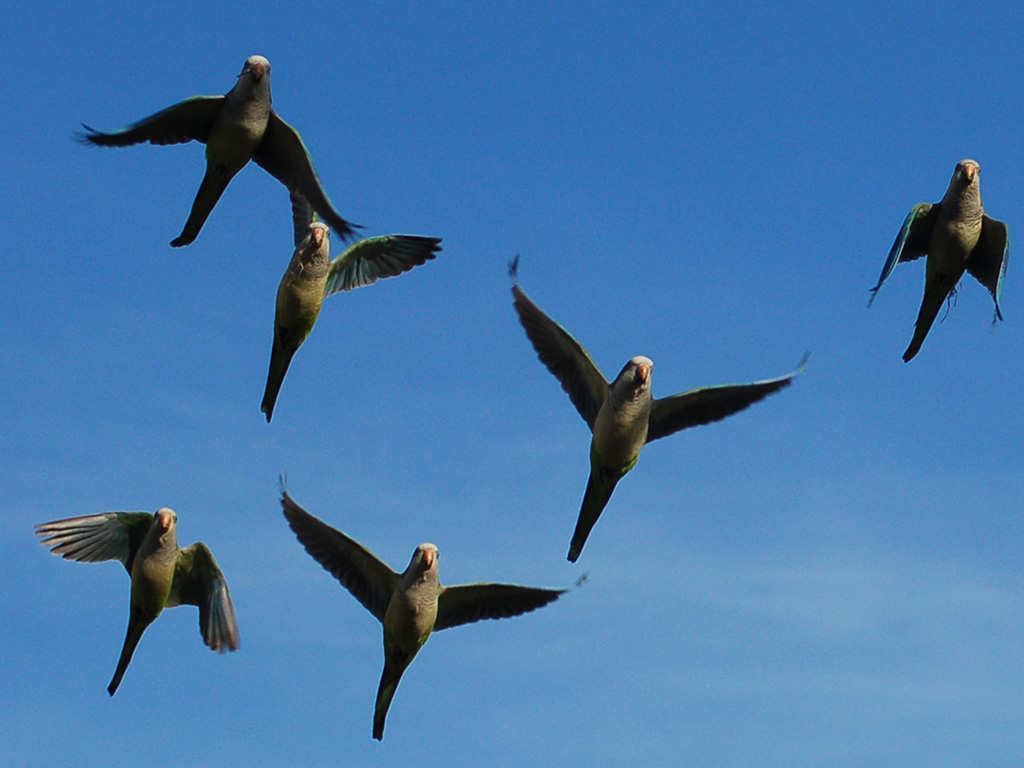
Photo: Wild Quaker Parrots in Flight Over Midwood, Brooklyn
How did they get here? It's a long story!
Attention all Urban Parrot fans: the next Wild Brooklyn Parrot Safari will happen on Saturday, October 4th, 2008, at 12 Noon. All interested wild parrot fans should meet at Brooklyn College's Hillel Gate, which is at the intersection of Hillel Place and Campus Road. Our tour runs in two sections. You can attend either section, or both, depending on how many wild parrots you'd like to see!
Please e-mail me if you want to attend, so I know how many folks are coming. Note: the rain date for this trip is Sunday, October 5th, same monk time, same monk location.
Wild Parrot Safari -- First Section (Brooklyn College): 12:00 Noon to 1:30PM
At noon, we'll inspect the Brooklyn Parrots' "Ellis Island." Their large nests around the soccer field represents the first major colony in Brooklyn. The site is easy to get to via public transportation. Just take the Number 2 train (Seventh Avenue IRT) to the end of the line, walk one block Southwest on Hillel Street past the new Starbucks, and look for the main Brooklyn College date. The tour begins at the entrance at Noon sharp. Allow some extra time, given that the MTA is doing lots of construction/train re-routing on weekends. Driving instructions are available at Brooklyn College's main Web site. Parking is fairly easy to come by in the neighborhood. If you're late, just call me: I'll give you directions so that you can meet up with us if the tour is already in progress.
Wild Parrot Safari -- Second Section (Green-Wood Cemetery): 2:30PM-5PM.
Due to popular demand, our monthly tour will run an optional "second section." After getting our share of the raucous antics of the Brooklyn College Parrots, at approximately 1:45 PM, our group will walk to the Q Train (BMT) station at Avenue H and journey to Green-Wood Cemetery, where we will observe the late-afternoon antics of the parrots residing there. If you just want to see the Green-Wood parrots, show up at 2:30 PM and we'll be there. To get to Green-Wood, take the R Train to 25th Street and walk one block East to 25th and 5th Avenue.
What to Bring/What to Wear
Please bring a photo ID (this is required by Brooklyn College Security). Bring binoculars and a camera if you'd like to immortalize your wild parrot-watching experience. The weather will be warm if not hot, and we'll be exposed to the wind and possibly strong sun, so bring a hat/sunscreen if you have sensitive skin. I ordinarily do not cancel the tour unless the forecast is for sustained rain in which birds will not fly.
Please feel free to wear anything except bright orange (Monk Parrots freak out when you show them something orange: in fact orange tags are one of the best ways to convince Monk Parrots to build away from electrical infrastructure). Wear green, blue, white, but orange will drive away the birds.
This Tour is Free, But the Parrots Are Hungry!
The Wild Parrot Safari is free - if you wish to help your hungry urban feathered friends, bring some bird seed: trust me, the parrots won't soon forget the gesture. Wild monk parrots also appreciate "real parrot food," especially unshelled peanuts, sliced apples, and raw sunflower seeds. Finch food or millet are always welcomed by our hungry urban "peeps."
See you in wild, exotic Brooklyn!
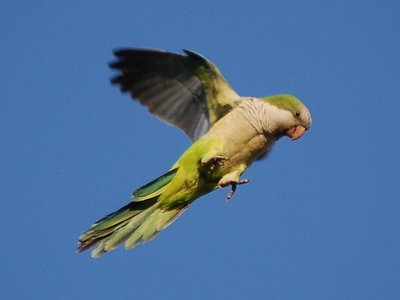
Tuesday, September 16, 2008
Parrots and Politics: Ralph Nader Speaks Extemporaneously With Highly Intelligent Parrot
As a non-profit organization, the Brooklyn Parrot Society (which runs this Web site) is prohibited from endorsing political candidates. Still, our board's chairman believes that the IRS will not revoke our pending 501 (c) (3) application just because we've embedded the following video spot, which features Ralph Nader having an extended conversation with a very intelligent parrot. Without conceding any endorsement of Mr. Nader's presidential campaign, this spot represents a gentler and more humane treatment of human-animal relations than any that could conceivably emerge from the camp of Republican vice-presidential candidate Sarah Palin, whose attitude towards animals (evinced by her enthusiastic endorsement of the practice of hunting animals from airplanes) is regrettably cruel.
Friday, September 12, 2008
Were Wild Monk Parrots Transported to the Northeast U.S.A. Via Hurricane Gloria?
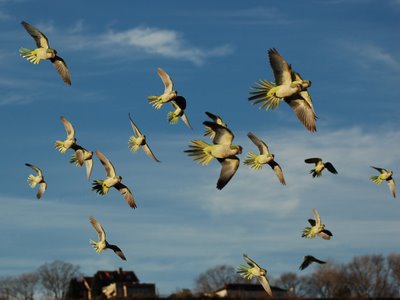
Did the Wild Monk (AKA Quaker) Parrots of the Northeast U.S.A. Hitch a Ride on Hurricane Gloria?
Like many, I've been surfing the Web searching for news of Hurricane Ike today. I happened to stumble across a very odd claim on a web page devoted to Hurricane Gloria, an extremely destructive storm which hit the New York area on September 27, 1985. On this page, there's an extraordinary claim that I couldn't resist mentioning:
One unusual occurrence after Hurricane Gloria was the number of parrots that took up residence along the Connecticut coast. Known a Monk Parrots - these tropical birds apparently became caught up in the eye of Hurricane Gloria as it passed just to the east of San Salvador Island in the Bahamas. The mild winter climate of the Connecticut coast allowed the birds to survive and breed in great numbers. Despite attempts by Connecticut Light and Power Company at eradication - the bright colored (yellow and green) tropical birds are still visible on telephone poles and in the marsh thickets along the Connecticut coast today. (emphasis added)
This is indeed the strangest claim about the arrival of monk parrots in the Northeast that I've ever heard. The notion that Monk Parrots have been using hurricanes to get around seems fantastical, but these little greenies may have some tricks up their sleeves that we barely know about. I'd have to do some more research before making any conclusions about this claim: it seems unlikely that many Monk Parrots would have been present in the vicinity of San Salvador Island in the 1980s but nobody's really explained why there are so many parrots living in the Northeast, their ability to survive violent weather, or why they seem to have arrived in the 1980s. I suppose anything in this big wild world is possible, especially when a big hurricane comes along!
Thursday, September 11, 2008
Video: Chirping Birds Cheer Veterans
It's no secret that watching birds can do wonders for your mood. I learned this first-hand about a year ago, when a clinically depressed lady saw wild Quaker Parrots for the first time on one of our Wild Parrot Safaris. She smiled -- for the first time in five years! That's when I realized what others have long known: watching nature, and particularly birds, can provide a powerful bullwark against depression.
So hats off to the people who run the Orlando Veteran’s Administration facility and Air Force veteran Norman Cass. With funds raised from a local V.F.W. post, a small aviary was installed in a common area and it's been a big hit with the disabled veterans who live there. Thanks to Diane West of New York Tails for bringing this video to light. You can read more about the aviary here.
In Our Hearts Forever
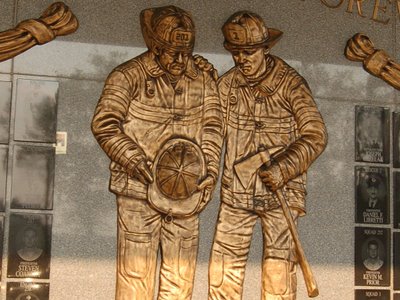
Memorial honoring Brooklyn firefighters lost September 11, 2001, Keystone Park, Brooklyn. Photo by Steve Baldwin, date 9/9/2006.
Monday, August 25, 2008
Photos: Battle of Brooklyn 232nd Anniversary
The Battle of Brooklyn took place 232 years ago. Here are some photos from the annual commemoration, which took place this past Sunday. Interestingly, the wild Quaker Parrots that live at Green-Wood Ceremony didn't seem to mind all the colonial hoopla, except for the firing of the rifles.
If you can't see the embedded slideshow, you can browse the pix on the Flickr Set I created for this event by clicking here.
Monday, August 11, 2008
Photo-Essay: New Wild Baby Quaker Parrots in Brooklyn's Green-Wood Cemetery
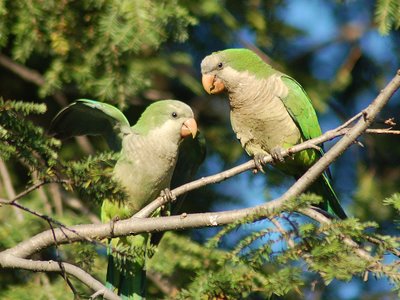
Wild-born baby Quaker (left) begs for food from mother at Brooklyn's Green-Wood Cemetery. All photos by Steve Baldwin.
People sometimes ask me what's the best season of the year to watch wild Quaker Parrots in the Northeast U.S.A. In some respects, Fall and Winter are better for seeing the parrots, because they form larger flocks, and because they're easier to see and photograph when the trees are bereft of leaves.
But if you want to see young baby Quakers flying, playing, and feeding for the first time, however, there's no better time than Summer. Right now, these fresh youngsters are shaking, quaking, and begging their parents to satisfy their appetites, and they're also beginning to learn the Quaker's main trade (nest-building) and how to forage for food.
Last week, I posted a brief photo-essay on the baby Quakers in Green-Wood Cemetery. Here's a follow-up with some new photos intended to welcome 2008's new additions to the wild Quaker Parrot flock.
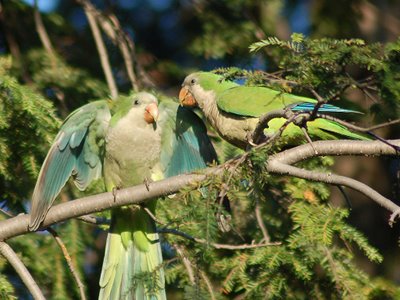
Baby Quakers will keep "quaking" for food until they've been trained to gather food for themselves.
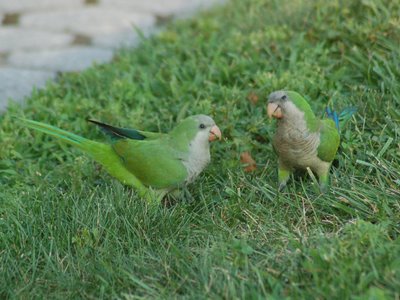
Here, Mom (on right) is teaching baby to eat grass, which is the main diet for wild Quaker Parrots.
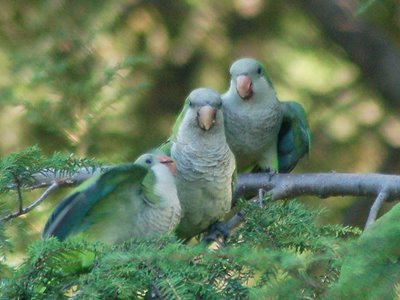
Mother bird (center) is kept very busy these days allo-feeding her young (this Mom has two to take care of).
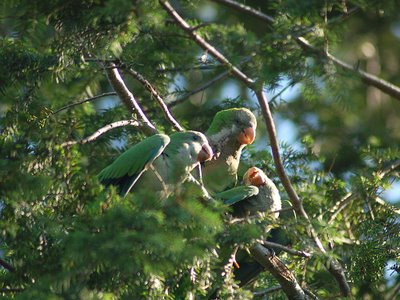
Another shot of Mom Quaker with her two hungry youngsters.
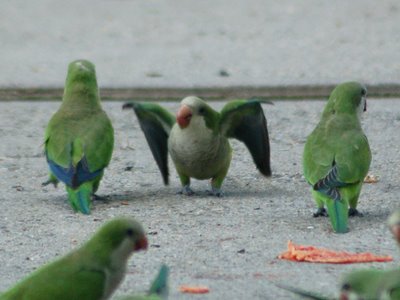
Across the river in Edgewater, NJ, baby Quakers are busy learning how to eat pizza.
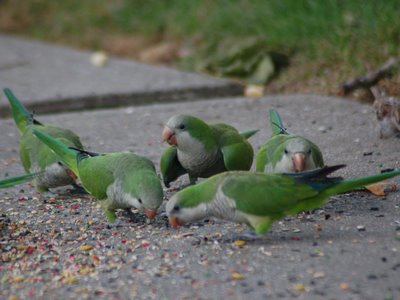
Baby Quakers look almost exactly like their full-grown parents when they emerge from the nests. You can spot them by their distinctive begging behavior, slightly different beak shape, and the fact that they look slightly "fresher" than grown-up birds.
Monday, August 04, 2008
New Photo-Essay: Wild Baby Quaker Parrots at Green-Wood Cemetery 2008
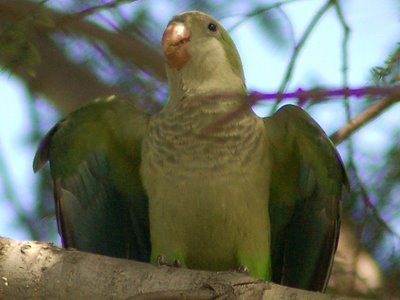
A wild baby Quaker Parrot at Green-Wood Cemetery, August 3, 2008
Each July and August, wild parrot watchers in the Northeast U.S.A. delight in the emergence of the latest and greatest crop of wild baby Quaker Parrots. At Brooklyn's Green-Wood Cemetery, these youngsters are easily seen in the grove of trees leading up to the main gate. The babies are inseparable from their parents, upon whom they depend for sustenance delivered through allofeeding (beak-to-beak feeding).
This past Sunday, I photographed some of these newcomers. They are just as cute as those seen in prior years.
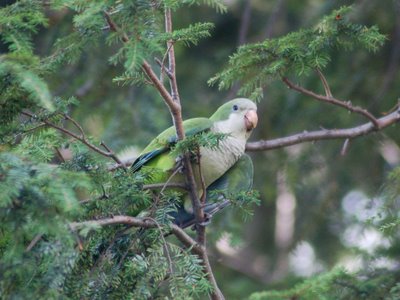
How do you spot a baby Quaker Parrot in the wild? Well, the shape of their beak is different, they're just a bit "fresher looking," and their characteristic begging behavior gives them away. Here's one in a tree awaiting Mom's return.
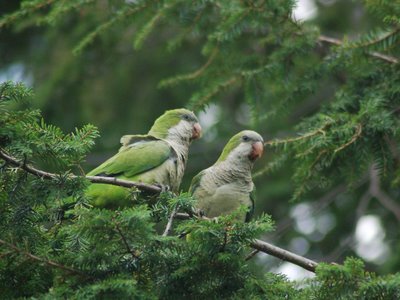
Here, you can compare Mom (on the right) with her hungry youngster. Note the differing beak shapes. Baby Quaker parrots sound very different as well; their calling is far less assertive than their elders.
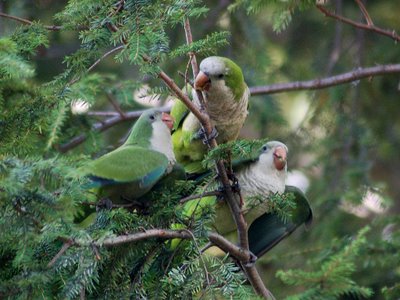
This busy Mom (center) is allofeeding two hungry babies today!
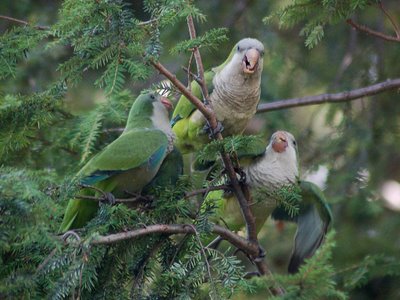
Another shot of Mom with kids.
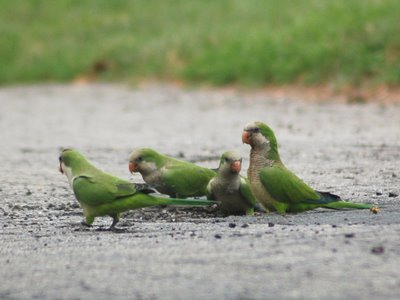
Baby Quakers closely shadow their parents. Here, three adult Quakers are digging a hole in a road; the purpose of this project appears to be to consume the soil beneath, which is thought to act as a digestive aid. The baby is second from left. This baby will maintain very close contact with his parents for at least a year and possibly longer.
Monday, July 28, 2008
Wild Parrots in Whitestone, Queens, NY
Wild Quaker Parrots have been living in Whitestone, Queens, for some years now, and the first reliable documentation of their presence there is from 1996. The parrots started out building tree nests in Frances Lewis Park below the eastern side of the Whitestone bridge, but a storm came in 2000 and dispersed them through the neighborhood. Since then they've holed up in power pole nests.
Nobody really knows how these parrots got to Whitestone. There is a large colony across the bay at Throggs Neck, and one in Pelham Bay. Perhaps the parrots in Whitestone are descendants of an early exploratory colony that made its way from JFK Airport in the 1960s. Some even speculate that the colony in Whitestone flew there from Rikers Island in the early 1970s to escape federal eradication efforts.
The fact that there are wild parrots -- even rare wild mitred conures -- roaming the skies of Queens should be a sign of Green Pride. While they may pose a headache for Con Edison and Verizon, they are a source of pride and amusement in the local neighborhood and serve as proof that Whitestone's ecology is sound. Several residents have expressed interest in installing monk bunker alternative nest platforms to house them.
Friday, July 25, 2008
Wild Parrot News From Beyond Brooklyn: Rare Parrot Hatched at Houston Zoo
One of these days, I'm going to have to visit Texas, not just because it's both the home of Railean Rum (the only booze branded with a Monk Parakeet) and is also the home of many wild Monks, but because the Houston Zoo recently hatched one of the most endangered parrots around: the St. Vincent Amazon. Only 800 St. Vincent Amazons are known to exist in the wild, which makes the hatching of Vincent this past May a welcome event. You can read more about Vincent on the site of the Houston Chronicle newspaper.
Tuesday, July 22, 2008
Wild Parrot News From Beyond Brooklyn: 100,000 Parrots Gather at Indian Temple
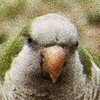 A temple in Indore, India, becomes home to hundreds of thousands of Indian Ringneck parrots each year. The parrots gather to eat grain left by worshipers. Check out this awesome BBC video depicting this mass gathering of green parrots. We've got plenty of parrots in Brooklyn but not this many!
A temple in Indore, India, becomes home to hundreds of thousands of Indian Ringneck parrots each year. The parrots gather to eat grain left by worshipers. Check out this awesome BBC video depicting this mass gathering of green parrots. We've got plenty of parrots in Brooklyn but not this many!Tuesday, July 15, 2008
Non-Parrot News: The Destruction of Washington Square Park
Community activist Sharon Woolums performs "When They Tore Down Washington Square Park"
I spend so much time in Brooklyn tracking wild parrots that I rarely set foot in Manhattan, the borough where I was born and spent most of my life. So I was shocked when I visited Washington Square Park recently and saw the rampant destruction visited upon it by bulldozers and tree cutters. More than 28 old-growth trees have already been felled, graves have been dug up, the storied fountain has been destroyed (and will be rebuilt with a 45-foot water spray device that will be loud enough to drown out musicians), and the path of destruction has only just begun. Soon a tall fence will be constructed around the park, further restricting access to rare green space in downtown Manhattan.
How did this happen? Why did what once a vital activist community roll over and let powerful interests "privatize" what was once the cultural heart of Greenwich Village? Here lies a story of intrigue and backroom political deals, and I learned enough about it to produce a song and video starring community activist Sharon Woolums, who fought in vain for three years to save Washington Square Park.
Thursday, June 26, 2008
Quaker Parrots Featured in New NYC Recycling Spot
A friend on the Quaker Parrot Mailing List pointed out that one of New York's new Green NYC Public Service Announcements appears to feature an animated Quaker Parrot. Of course, real Quaker Parrots don't say "Tweet, Tweet;" they say "Ack Ack." But I'm glad to see one of Brooklyn's own wild Quakers promoting a "Green New York," because more trees mean more places for our remarkable green parrots to perch upon!
Sunday, June 15, 2008
Wild Parrot News From Beyond Brooklyn: Californians Rally to Declare Parrot As New State Bird
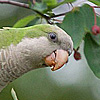 The proprietors of ParrotNotQuail.com have organized an online petition which they hope will result in a parrot replacing the quail as the California State Bird. According to the site, more than 200,000 people have signed it.
The proprietors of ParrotNotQuail.com have organized an online petition which they hope will result in a parrot replacing the quail as the California State Bird. According to the site, more than 200,000 people have signed it.California is home to a sizable population of wild parrots (whose most storied members are found in San Francisco), and while it's gratifying to see the Golden State's indigenous parrots getting some high-visibility cyber-recognition, California has a bad record in terms of being friendly to our beloved Quaker Parrots, being one of only two U.S. States in which ownership of a pet Quaker is a crime. My hope is that this new movement will underscore the degree to which wild parrot flocks are largely a "value-added species" to North American skies.
Wednesday, June 11, 2008
Brooklyn Parrots on PetLifeRadio.com
 PetLifeRadio.com, a recently-launched pet podcasting site, just uploaded an audio interview between myself and Diane West, editor of NewYorkTails.com. You can listen to this interview or download it to your ipod by clicking here.
PetLifeRadio.com, a recently-launched pet podcasting site, just uploaded an audio interview between myself and Diane West, editor of NewYorkTails.com. You can listen to this interview or download it to your ipod by clicking here.Labels:
Thursday, June 05, 2008
Bay Ridge Parrots Face Uncertain Future
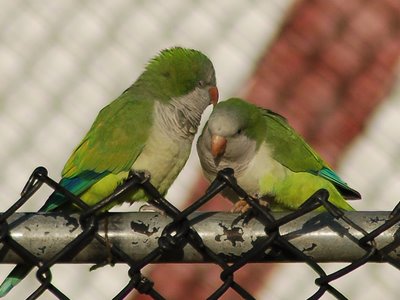
Two wild Quaker Parrots at Bay Ridge's Dust Bowl.
The wild parrots which have long lived around one of Brooklyn's last sandlot baseball fields, an area dubbed "The Dust Bowl," will soon face down a $3.2 million renovation of the field that will significantly alter their ecosystem. As reported in the Brooklyn Courier Life newspaper, the project, whose funding was secured by City Councilman Vincent Gentile, involves construction of a "secure synthetic multi-use field consisting of new dugouts, new accessible entrances, six new handicap-accessible drinking fountains and new synthetic turf" and is scheduled to begin this Fall. After completion, the Dust Bowl area will be off-limits to the public, and only be open to authorized sports teams supplied with keys.
While advocates for the project have claimed that steps will be taken to protect the wild parrots during construction, it is highly troubling that synthetic turf will now replace what has been a natural environment of sand and turf, upon which wild birds, including the parrots, regularly forage upon. Synthetic turf is made from recycled rubber tires, and physicians have already raised concerns that it becomes toxic under certain conditions. It cannot be known what long-term effects this will have on the local fauna, or, for that matter, the human population. Losing open access to the Dust Bowl, one of Brooklyn's last genuine "sand lot" fields, is also a concern. Why must humanity always insist on replacing something natural and wild with something artificial and sterile?
Friday, May 30, 2008
Breaking News: Connecticut Wild Parrots Face New and Deadly Threat
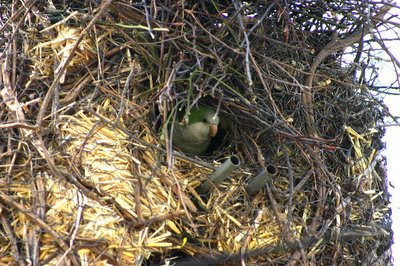
A wild Quaker Parrot in Connecticut takes up a defensive position in preparation for further human assaults on his colony.
Two and a half years after activists successfully halted United Illuminating's deadly campaign against the wild parrots of Connecticut, a Connecticut Superior Court judge has allowed UI to resume its parrot-killing policy. While there is no immediate indication that United Illuminating will resort to such deadly measures in the next few weeks, it now has a legal free hand and it appears that nothing short of an act of the Connecticut legislature can spare the parrots from further harm.
This legal defeat is a serious blow to Wild Parrot Conservationists and other groups concerned with the welfare of wild animals. From what I have learned, it appears that the legal strategy pursued by Friends of Animals was deeply flawed. The groups has stated that it intends to appeal the decision but the damage is deep, and the parrots will find themselves in serious danger in the weeks and months ahead.
No comments:
Post a Comment